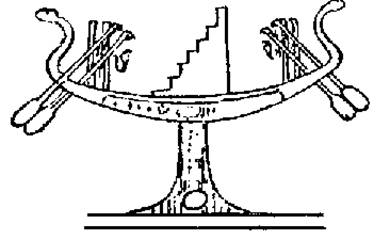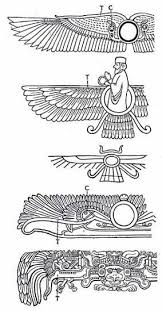It looks like you're using an Ad Blocker.
Please white-list or disable AboveTopSecret.com in your ad-blocking tool.
Thank you.
Some features of ATS will be disabled while you continue to use an ad-blocker.
share:

Unless you have knowledge of the stars you wouldn't know that to a person observing the stars they seem to be rotating around a single star, the pole star. the sky is a whirlpool rotating around this single star and to the priests of ancient Egypt they believed it was heaven, the doorway to the other world.


The pyramid is a spiritual device, literally a stairway to heaven. It is equivalent to the solar boat which guide the soul of the pharaoh to the other world. It is very similar in concept to Jacobs ladder in the bible which the angels use to travel from Earth to heaven and heaven to Earth.
The ancient Egyptians believed in a Earthly paradise also, a hypoborean pre flood land at the north pole.
The pyramid then is amongst other things (because its function is physical, energetic and spiritual) a spiritual device which launches the soul of the pharaoh into the star whirlpool, literally a stargate.
For this reason all pyramids are orientated northwards as has been observed
The pyramids of Egypt could be explained as symbolic stairways to the stars, according to a British scientist.
Toby Wilkinson, an Egyptologist based at Cambridge University, told a conference over the weekend that some of his theory was "deliberately controversial, provocative, but tantalising". He argued, from evidence of the orientation of the pyramids - always to the northern pole star - and from the names given to estates to finance funerary cults, and the shape of the pyramids themselves, that they could be seen as launch pads for the pharaoh's journey to the afterlife among the stars.
www.theguardian.com...
Pyramids of South America/Peru also have the same alinement's and basic function, perhaps ziggurats also served this purpose. An interesting observation is that wherever you find pyramids you also find the winged disc symbol which neatly describes the purpose of the pyramids.

Pyramids are towers which reach to heaven much like the tower of babel
edit on 13-3-2016 by zinc12 because: (no reason given)
a reply to: zinc12
Assuming you mean "ladder", great pyramid thread.
Pharaohs were an interesting bunch
edit to add:
Speaking of which, an interesting record of the conversation of Pharaoh and Jacob may be read in Genesis 47:8
why would that be the first question one asks a stranger?
It is very similar in concept to Jacobs latter in the bible
Assuming you mean "ladder", great pyramid thread.
Pharaohs were an interesting bunch
edit to add:
Speaking of which, an interesting record of the conversation of Pharaoh and Jacob may be read in Genesis 47:8
why would that be the first question one asks a stranger?
edit on 03017v2016Sunday by wisvol because: addition
a reply to: Phage
Maybe Pharaoh didn't chit chat in the same way with all shepherds who enter Egypt
edit to add:
furthermore, longevity seems to have been an important theme to pyramid architects, body preservation techniques corroborating the assumption.
There were said to be people living what would be considered even now with the light of collagen and vitamin supplements as unusually long lives, and perhaps their appearances would bear similarities distinguishable by the Pharaohs
Maybe Pharaoh didn't chit chat in the same way with all shepherds who enter Egypt
edit to add:
furthermore, longevity seems to have been an important theme to pyramid architects, body preservation techniques corroborating the assumption.
There were said to be people living what would be considered even now with the light of collagen and vitamin supplements as unusually long lives, and perhaps their appearances would bear similarities distinguishable by the Pharaohs
edit on 04019v2016Sunday by wisvol because:
addition
a reply to: Rosinitiate
Yes.
And if you want to climb really a lot, and if you don't have steel, a pyramid is your best bet if you want to build something to do so.
Mountains work too, though. There are some pretty "sacred" mountains.
Yes.
And if you want to climb really a lot, and if you don't have steel, a pyramid is your best bet if you want to build something to do so.
Mountains work too, though. There are some pretty "sacred" mountains.
edit on 3/13/2016 by Phage because: (no reason given)
a reply to: Phage
Only if your goal is longevity of the building
Babylonians build brick towers instead, which were also pretty "big" and could be climbed upon a lot more
And if you want to climb really a lot, and if you don't have steel, a pyramid is your best bet if you want to build something to do so.
Only if your goal is longevity of the building
Babylonians build brick towers instead, which were also pretty "big" and could be climbed upon a lot more
originally posted by: Phage
a reply to: Rosinitiate
Yes.
And if you want to climb really a lot, and if you don't have steel, a pyramid is your best bet if you want to build something to do so.
Mountains work too, though. There are some pretty "sacred" mountains.
Earth mound is the easiest or modified hill (which have been found ie reshaped hills), next brick tower, then pyramid.
In his book, Structures or why things don't fall down (Pelican 1978–1984), Professor J.E. Gordon considers the height of the Tower of Babel. He wrote, 'brick and stone weigh about 120 lb per cubic foot (2,000 kg per cubic metre) and the crushing strength of these materials is generally rather better than 6,000 lbf per square inch or 40 megapascals. Elementary arithmetic shows that a tower with parallel walls could have been built to a height of 2.1 km (1.3 mi) before the bricks at the bottom were crushed. However, by making the walls taper towards the top they ... could well have been built to a height where the men of Shinnar would run short of oxygen and had difficulty in breathing before the brick walls crushed beneath their own dead weight."
edit on 13-3-2016 by zinc12 because: (no reason given)
a reply to: Phage
suggesting, no
reporting, yes
Except the miles high part
Clay, even cooked, tends to get back to clay after some centuries but architects of that school have left other clues. Modern clay brick makers of the area will have interesting insight
Are you suggesting that the Tower of Babel actually existed and was miles high?
suggesting, no
reporting, yes
Except the miles high part
Clay, even cooked, tends to get back to clay after some centuries but architects of that school have left other clues. Modern clay brick makers of the area will have interesting insight
edit on 00202v2016Sunday by wisvol because: clarification
originally posted by: Phage
a reply to: zinc12
The compressive strength of the materials used to build a structure is not the only consideration. Are you suggesting that the Tower of Babel actually existed and was miles high?
Since you are reading a thread I myself created it should be obvious to you that I know it is not necessary to build a structure miles high. The energy field generated by a correctly constructed pyramid reaches heaven but energetically not physically.
The quote I provided is simply to show that a pyramid is not the easiest structure if your sole goal was height, a brick tower is.
a reply to: zinc12
Pyramids do not create energy fields.
The energy field generated by a correctly constructed pyramid reaches heaven but energetically not physically.
As I pointed out, compressive strength is not the only consideration in building a tall structure. But, I did after all, say that as far as building a very large structure goes, a pyramid is the simplest way to do so.
The quote I provided is simply to show that a pyramid is not the easiest structure if your sole goal was height, a brick tower is.
edit on 3/13/2016 by Phage because: (no reason given)
a reply to: Phage
Thanks for clarifying.
OP seems to have been referring to your statement that
because climbing works better on towers that may at equal or smaller base and less construction effort be taller than stone pyramidal buildings that have indeed taken over Babylonian astronomic & religious edifices as per the example you quoted earlier
But, I did after all, say that as far as building a very large structure goes
Thanks for clarifying.
OP seems to have been referring to your statement that
And if you want to climb really a lot, and if you don't have steel, a pyramid is your best bet if you want to build something to do so.
because climbing works better on towers that may at equal or smaller base and less construction effort be taller than stone pyramidal buildings that have indeed taken over Babylonian astronomic & religious edifices as per the example you quoted earlier
a reply to: wisvol
Wow. Quite a run-on sentence there.
Why does climbing a tower work better than climbing a pyramid?
What towers were higher than the pyramids?
because climbing works better on towers that may at equal or smaller base and less construction effort be taller than stone pyramidal buildings that have indeed taken over Babylonian astronomic & religious edifices as per the example you quoted earlier
Wow. Quite a run-on sentence there.
Why does climbing a tower work better than climbing a pyramid?
What towers were higher than the pyramids?
originally posted by: Phage
a reply to: Rosinitiate
Yes.
And if you want to climb really a lot, and if you don't have steel, a pyramid is your best bet if you want to build something to do so.
Mountains work too, though. There are some pretty "sacred" mountains.
So than its settled, pyramids are in fact ascension machines.
new topics
-
Nvm
General Chit Chat: 3 hours ago -
OK this is sad but very strange stuff
Paranormal Studies: 9 hours ago -
Islam And A Book Of Lies
Religion, Faith, And Theology: 10 hours ago
top topics
-
Sorry to disappoint you but...
US Political Madness: 12 hours ago, 13 flags -
Watch as a 12 million years old Crab Emerges from a Rock
Ancient & Lost Civilizations: 17 hours ago, 10 flags -
OK this is sad but very strange stuff
Paranormal Studies: 9 hours ago, 7 flags -
Islam And A Book Of Lies
Religion, Faith, And Theology: 10 hours ago, 5 flags -
Nvm
General Chit Chat: 3 hours ago, 2 flags
active topics
-
Matthew Livelsberger said he was being followed by FBI
Political Conspiracies • 73 • : 38181 -
Islam And A Book Of Lies
Religion, Faith, And Theology • 5 • : BeyondKnowledge3 -
OK this is sad but very strange stuff
Paranormal Studies • 4 • : chiefsmom -
Here we again... CHINA having mass outbreak of something
Diseases and Pandemics • 28 • : Cracka -
Musk calls on King Charles III to dissolve Parliament over Oldham sex grooming gangs
Mainstream News • 184 • : ufoorbhunter -
Can we be certain that Jesus Christ was born on December 25th?
Religion, Faith, And Theology • 35 • : covent -
What Is 'Quad Demic'? Mask Mandate Returns In These US States
Diseases and Pandemics • 41 • : Cracka -
Tesla Cybertruck Explodes in Front of Trump Hotel in Las Vegas
Mainstream News • 230 • : imitator -
Remember when Iraq invaded Kuwait
History • 31 • : Cracka -
Sorry to disappoint you but...
US Political Madness • 16 • : TzarChasm
